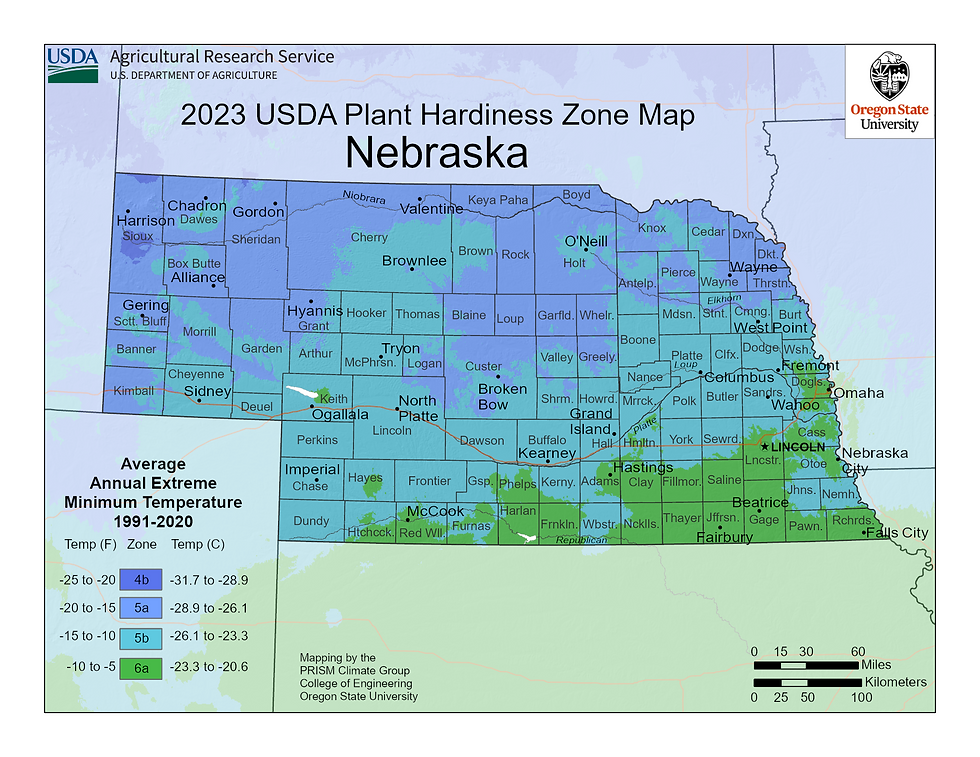USDA Hardiness Zones Across the U.S. - Spotlight on Nebraska!
- Marcus Bergin

- Aug 13, 2024
- 2 min read
Discover Your USDA Hardiness Zone!
Are you ready to cultivate a thriving garden in Nebraska? Understanding your USDA Hardiness Zone is essential for selecting plants that can withstand the state’s diverse climate, from the Great Plains to the Sandhills. Let’s explore the zones across Nebraska and find the best shade-tolerant plants for your garden!

Nebraska: Zones 4-5
Nebraska’s climate ranges from cold winters to hot, dry summers. Here’s a closer look at the zones in Nebraska and some shade-tolerant plants that will thrive in each:
Zone 4:
Found in the northern and western parts of Nebraska, where winter temperatures can drop to -30 to -20°F. These hardy, shade-tolerant plants are perfect for the cooler regions:
Hellebores (Helleborus spp.): Known for their early spring blooms, Hellebores thrive in the cool, shaded areas of Zone 4 and add color to your garden when most other plants are still dormant.
Ferns: Varieties like Lady Fern (Athyrium filix-femina) and Maidenhair Fern (Adiantum spp.) bring lush greenery to shaded spots in your garden, even in the coldest conditions.
Columbine (Aquilegia spp.): With its delicate, nodding flowers, Columbine is a great choice for adding elegance to shaded areas in Zone 4.
Zone 5:
Covers much of central and eastern Nebraska, including cities like Omaha, Lincoln, and Grand Island, where winter temperatures range from -20 to -10°F. This zone supports a wide variety of shade-tolerant plants:
Hostas (Hosta spp.): A classic choice for shade gardens, Hostas offer lush foliage in a variety of colors and patterns, thriving in the cooler, shaded areas of Zone 5.
Bleeding Heart (Dicentra spectabilis): Known for its heart-shaped flowers, Bleeding Heart adds charm to shady garden spots in spring and early summer.
Astilbe (Astilbe spp.): With its feathery plumes of pink, white, or red flowers, Astilbe adds bright color to shaded gardens and prefers the cooler conditions of Zone 5.
Why It Matters:
Optimal Plant Selection: Choosing plants that are well-suited to your specific zone ensures they will thrive and contribute to a healthy, beautiful garden.
Effective Garden Planning: Understanding your zone helps you plan your planting schedule, allowing you to take full advantage of Nebraska’s growing seasons.
Sustainable Gardening: By selecting plants that naturally thrive in your zone’s conditions, you reduce the need for extra water, fertilizers, and pesticides, promoting a more eco-friendly garden.
Get Involved: Share Your Gardening Experience
We want to hear from you! Whether you’re gardening in the cooler regions of Zone 4 or the slightly warmer areas of Zone 5, your experiences and tips can inspire and guide others.
Join the Conversation:
Comment Below: Share your gardening successes, challenges, and questions with fellow Nebraska gardeners.
Join Our Facebook Group: Connect with a community of shade gardening enthusiasts by joining our Shade Gardening Group on Facebook. It’s a great place to exchange ideas, find inspiration, and support your gardening journey.
Let’s grow together, Nebraska! 🌻




Comments